Then a couple of weeks ago he called me and mentioned that he was going to be stateside for a bit. He planned to boondoggle a few days in the Bay Area and asked if I'd be up for going sailing. Given all of the little things that are wrong with the boat and all of the big things that are stacking up on my to-do list, I hesitated for a moment. Fortunately, reason found its way into my head and reminded me that I bought the boat for sailing and I never get to spend enough time with Rich anyway.
When I say there were little things wrong with the boat, I have to place emphasis on the word "little." The most significant concern was a dead light bulb in the anchor light. Fixing it meant going aloft all the way up to the tippy top of the main mast and unscrewing this little fitting:

It wasn't until I'd hoisted myself all fifty or so feet up that I realized that I went all the way up with the wrong size bulb. The bulb I had fit in the socket, but there was no way to put the cover back on over it. Good enough.
I was also having a few issues in the engine room. Here's a picture of me having issues in the engine room:
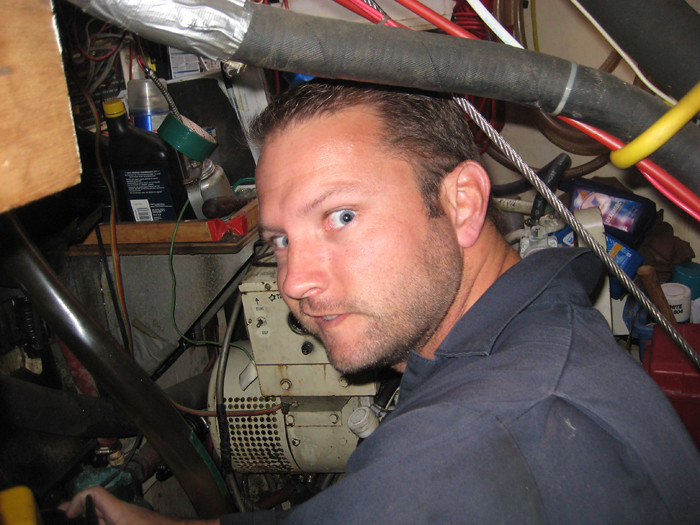
Other than that, the only things I needed to do before getting underway were replacing the little shackles along the foot of the main and mizzen sails and finding a new home for these little guys living inside the cover for my mainsail:
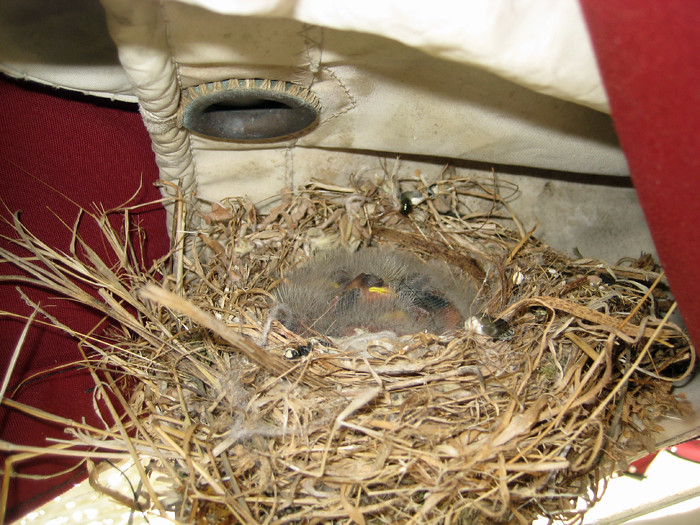
All too easy.
WEDNESDAY: Singlehanding to the South Bay
0630: Reveille
0720: Underway for pumpout station
0820: Departing Petaluma Marina under power
0850: Proceeding downriver under power/sail
1112: Passing channel markers 9 & 10:
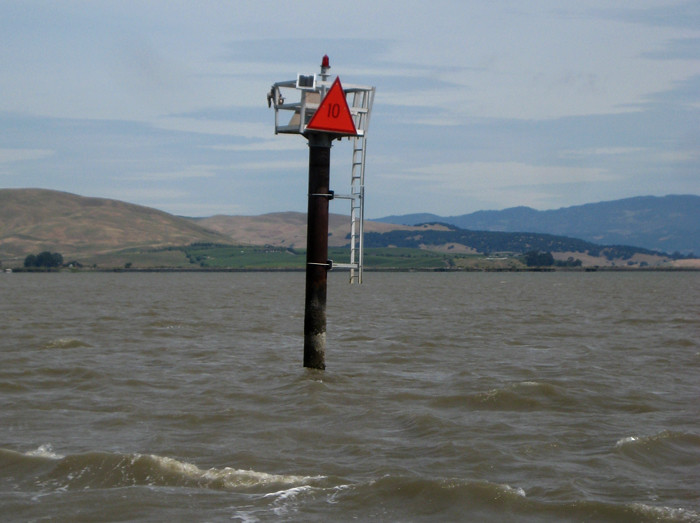
1303: Moored at Loch Lomond Marina in San Rafael for fuel. I took on a total of 105 gallons of diesel fuel, so it gave me a few minutes to chat with the guy working at the fuel dock. Turns out he's a Vietnam veteran and he and his wife live aboard a sailboat there in the marina. Nice guy.
After settling the bill, I walked ashore to grab lunch. On the way I felt like somehow I was being watched:

The guy at the bait shop says this bird's name is "Nasty."
1400: Underway from Loch Lomond
1616: Passed the only commercial traffic I've seen all day:
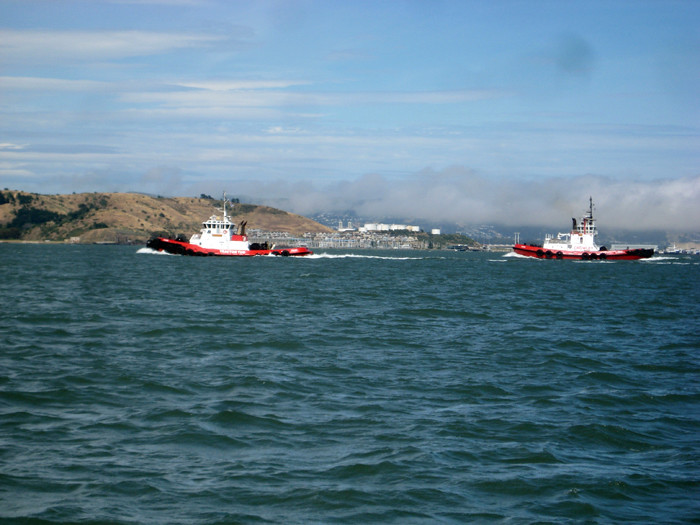
As I passed Raccoon Straits, I got a good shot of the fog coming through the Gate:
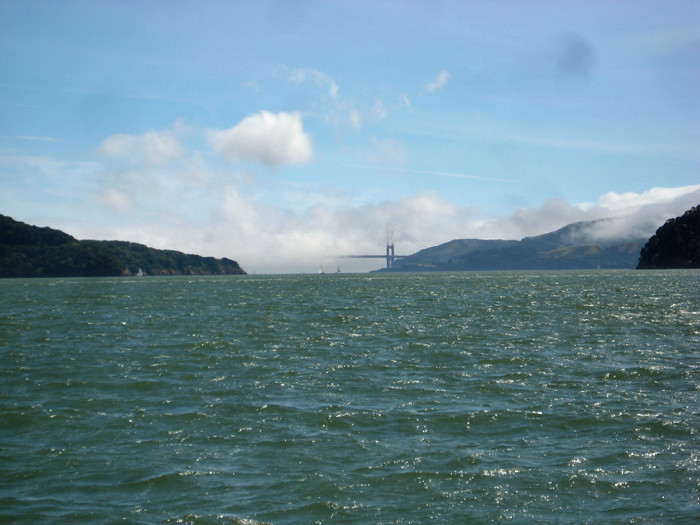
1859: Entering Oyster Point Approach Channel
As I motored into the Oyster Point Marina, I found the guest dock completely full. With no other idea of where to go I went ahead and tied up at the fuel dock.1914: Moored at Oyster Point Marina
When I had the boat tied up, I walked up to the harbormaster's office to find that there was nobody there. I called the number posted on the door and got a machine, so I figured I'd just stay at the fuel dock overnight and take off when they opened for business in the morning. At this point, the only thing I needed was a shorepower connection so I could charge my battery banks and call it a night.
For some reason it seemed that none of the shore power outlets that I tried were working. I was in the middle of trying to find a working outlet when I was interrupted by one of the more annoying phone calls I've received in years. It got me so spun up in fact that I completely failed to notice the rather simple detail that kept me from being able to plut in. Note to self: recognize the worth and value of caller ID.
At some point while I was messing up my shore power, I noticed that a harbor patrol officer had shown up at the harbormaster's office. When I walked over to check in, he pointed out that I needed to move to a different slip and it was time to cast off again. Somewhere in the conversation he expressed a bit of surprise/concern that I was moving such a large boat singlehanded.
"It's no big deal as long as you stay ahead of things," says I. I'm still convinced that's true.
So I shoved off and headed to the docks at the far end of the marina where the officer told me to find an empty slip. The only problem was that there was no empty slip. I didn't find this out until I'd turned into the 45-foot wide passage between the docks. This is where it's worth pointing out that my boat is 41 feet long. For a lesser mariner, turning a single-screw boat around in this kind of cramped space would be nigh unto impossible. For me it was just a matter of concentration and control.
Still, in the five minutes I spent backing and filling to turn the boat around, about a dozen residents of the marina started popping up everywhere to stand and stare and wait for me to collide with something. Several of them even brought out big rubber fenders just in case I crashed into their boats. I'm proud to say that I managed the turn without coming within 18 inches of any boats on either end. I rock.
Then it was time to motor to the other end of the marina where the harbor patrol officer emphatically assured me that there were in fact empty slips. As I turned down another row of slips I found him standing at the end of one of them. That's when he asked me how wide the boat was.
"She's thirteen and a half feet on the beam," says I.
"Oh," says he, "these slips are too small, but there's wider ones over that way."
So it was time to make another tight-squeeze-U-turn. Once again I ended up with an audience of paranoid boaters standing by to fend me off if things got too close.
As I headed back toward the main channel at dead slow speed, I was looking out for the officer to wave me into a slip. He didn't pop out anywhere until after I'd passed him. This meant that I'd have to back up, twist the boat to point toward the slip, and then keep control of the headway with the wind pushing me forward to prevent crashing into the dock. Meanwhile, another crowd had gathered on the dock, worried that someone with a big boat and only one person on board was about to wreck their floating homes. Fun.
Everything went well at first. I backed the stern into the wind, pointed the bow into the slip, and started creeping forward, checking the headway against the wind. In fact, it was all going perfectly. Then one of the marina residents "helped" me by grabbing one of my docklines and pulling my bow toward the dock on the starboard side.
With the unexpected spin, I didn't have time to keep the stern from swinging to port. Then the wind caught and swung me faster sideways as the stern was pushed. I ended up bumping the dock pretty hard amidships on the port side. It left a pretty noticeable skid mark, but at least there was no real damage.
2053: Moored. Again.
I can't really complain about the well-meaning folks who helped make up the boat once I was alongside. I had it handled all by myself, but I can understand why they'd be worried that something was about to go wrong.
Sometime later Rich called to let me know that his flight was delayed. His new ETA at SFO was 0045 on...
THURSDAY: Northbound with Rich
Rich got to the boat at about 2am. We sat and chatted for a while, but I can't for the life of me remember what we were talking about. I was well overdue for some rest at that point.
0400-ish: For no earthly reason, Rich is awake and alert.
0630-ish: The saner member of the crew wakes up to find a warm, calm, and overcast day with a bit of a breeze from the West.
0830-ish: Returned gate key to the harbor master.
0842: Main engine light-off0851: Underway
0912: Main engine shutdown. Underway under sail.It was a nice, calm day on the bay: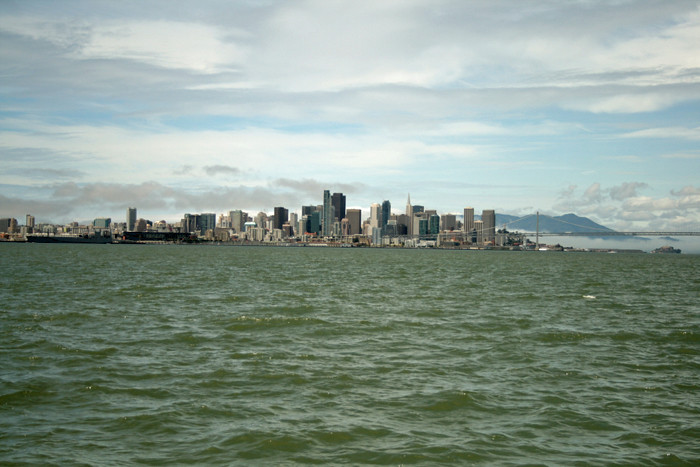
1410: Passing Under the Bay Bridge: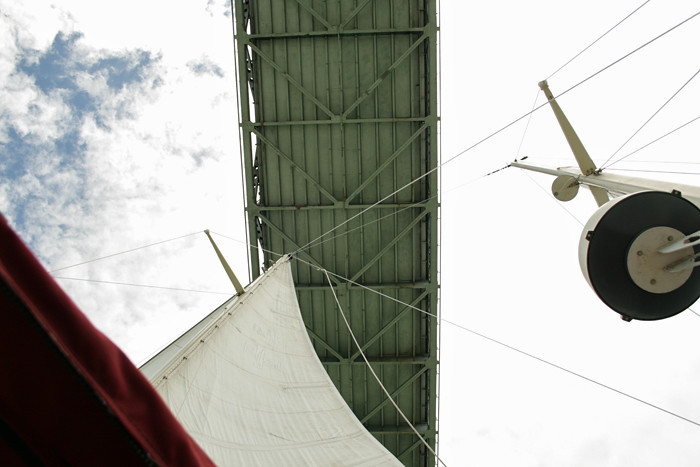
As we passed between the city and Treasure Island, we got a great view of the fog rolling in through the Gate:
The nice part about sailing the bay on a Thursday was that there were hardly any other boaters out there. Here's one of the very few (six at the most) sailboats we saw all day: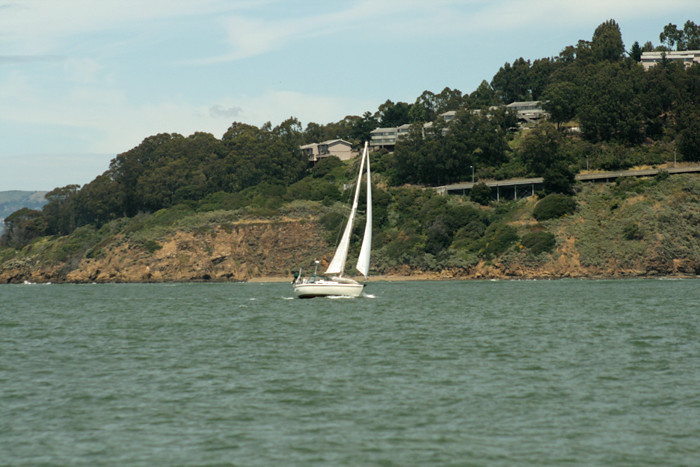
It was a great day to be out though, despite the whisper of fog: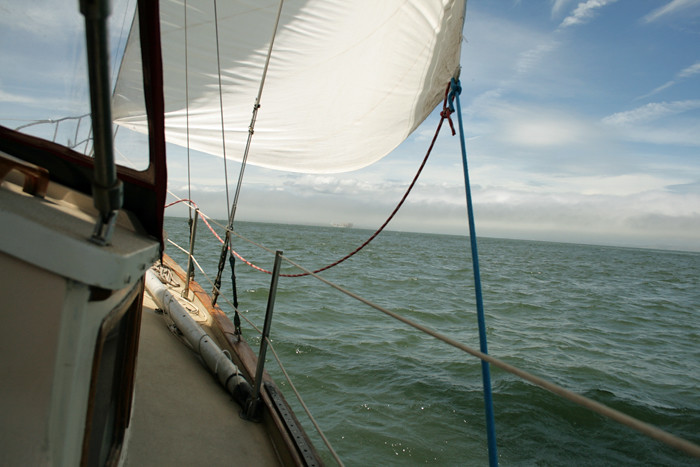
It was a bit warm in the south bay, but the fog helped keep things cool as we crossed the slot. In fact, at some point we had to start adding layers of clothing to ward off the cold.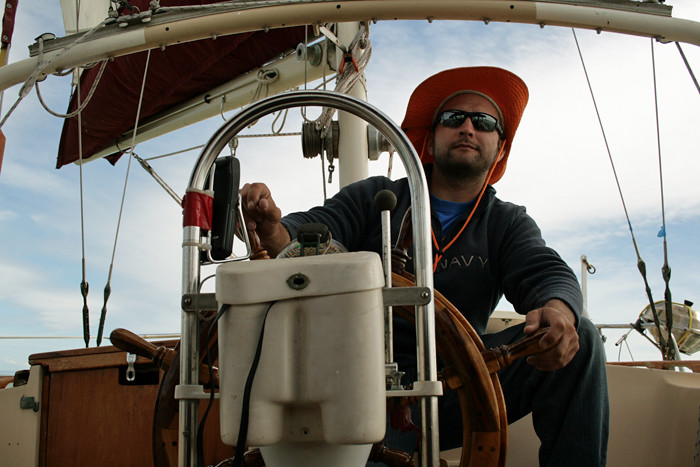
1543: Passed under the San Rafael-Richmond Bridge, to windward of Red Rock.
1759: Approaching Anchorage. We decided to end the day at anchor off of China Camp. Unfortunately the area is perilously shallow for a boat with the draft of Heart of Gold, so we had to make the tradeoff between potentially grounding in calm but water close to shore or in spending the night in choppy water farther off. We ended up with six feet of water under the keel when we set the hook, so I suppose we could've gotten closer in than we did.
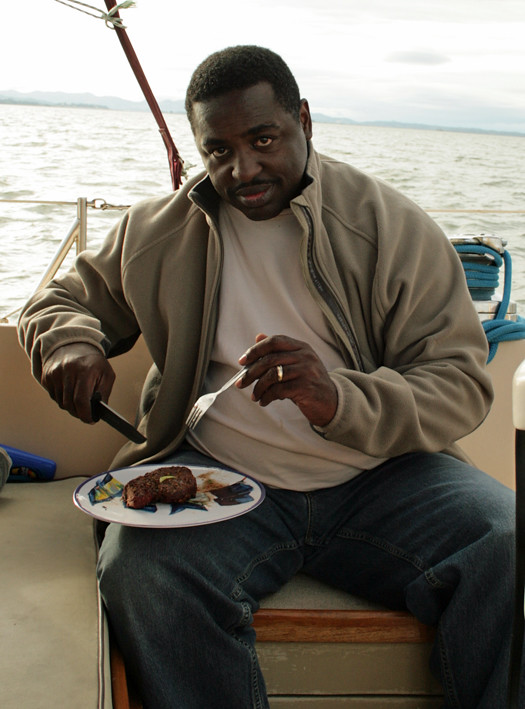
I used the bigger one for myself:

After dinner we sat around in the cockpit, telling stories, trading jokes, and finishing off a bottle of pinot noir.
It was a good day:
FRIDAY: Up the River

The day started with me cranking out a couple of omelettes. When making omelettes, I like to impress myself by flipping them over with a deft flick of the pan rather than using the more pedestrian spatula method. Because I savor the opportunity to impress people with my trivial skills, I made a point to show off my omelette flipping for Rich
ME: Did you see that?
RICH [smugly]: Yeah. It looked like you were about to float test an omlette.
Some people just find no wonder in the world.
With breakfast finished and the dishes securely piled in the galley sink, it was time to get underway. Rich took the helm and I headed forward to drive the anchor windlass. On my way up I snapped this pic:
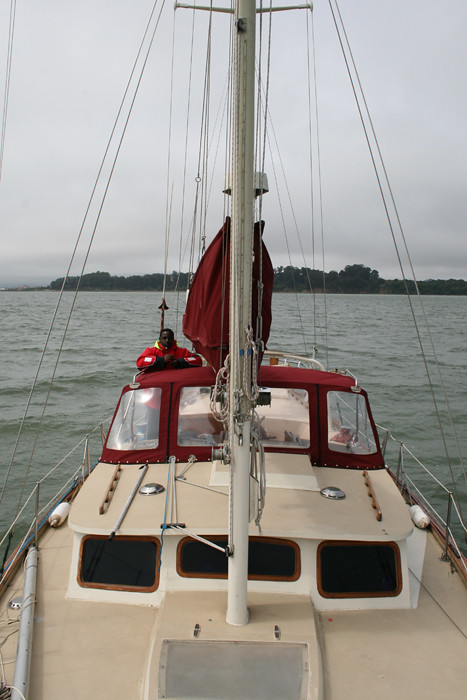
10-something: As we started heaving in, it became immediately clear that we were going to have trouble. The wind and the current were running in contrary directions. This meant that the wind was pushing the boat one way above the water and the current was pushing the other way under the water. As a result, the anchor chain was trailing from the bow under the length of the boat.
The first idea was to turn the boat around by hauling up the mizzen sail and pointing the boat into the wind. This proved impossible and all we ended up doing was going in circles around the hook as the wind and the current took turns as the main driving force moving the boat. After the seventh or eighth lap, we decided to just lower the sail, start the engine, and motor the stern around into the wind so we could haul in the hook against the current.
Once we had the anchor in sight, we turned toward the wind, hoisted the mizzen, unfurled the jib, and shut down the engine. The plan was to sail across the current and into the wind until the tide turned, then follow the wind and current up the river to Petaluma.
Rich spent much of this time at the helm while I kicked back and handled lines:

1418: Passing Markers 1&2, Entering Petaluma River Channel
1612: Passed an unorthodox boater in the river:
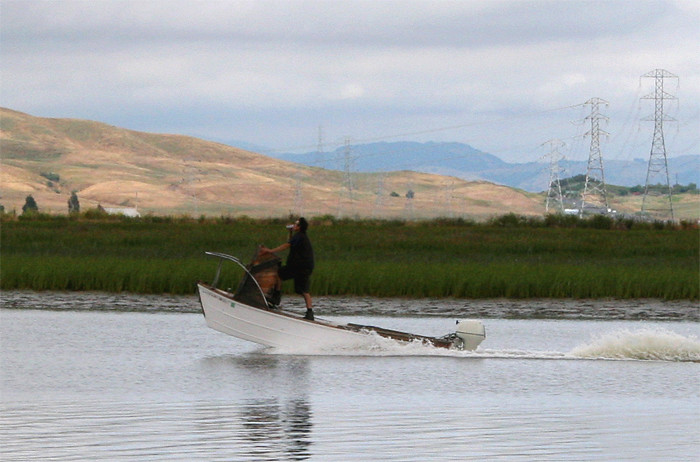
1805: Enter Petaluma Marina
1819: Give up on holding tank pumpout system, underway for berth.
1823: Moored.
1830: Main Engine Shutdown
In the end we managed to get there and back again with no major injuries or damage to the vessel or crew. I can't express how nice it was to be back out on the water for a little while.
Now back to my regularly scheduled life...

No comments:
Post a Comment